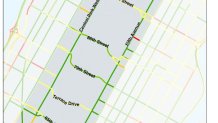The Metropolitan Transportation Authority’s plan for congestion pricing is forecast to significantly reduce vehicular traffic in Manhattan. Under the proposal, tens of thousands of commuters who would otherwise drive their cars and trucks would likely decide to take mass transit in order to avoid a toll of up to $23.
The plan — to charge drivers who move their vehicles south of 60th Street — would almost certainly trigger an overall decrease in the region’s traffic and air pollution. But some fear a handful of neighborhoods could actually see gridlock increase.
Since the FDR Drive, West Street, and roads north of 60th Street would be toll-free, drivers seeking to avoid paying the congestion fee could pile onto nearby blocks — burdening the people who live and work on the immediate outskirts of the toll zone.
"The streets are not going to be able to handle all that re-routing," said Stacey Sosa, owner of Estancia 460, an Argentinian bistro on Greenwich Street, sandwiched between the Holland Tunnel on-ramp and exit ramps. Under congestion pricing, Sosa fears her block could be overrun with toll-averse drivers as they try to make a b-line for West Street, which is free.
"Having the experience of a quiet neighborhood is very rare in New York City, so that will not be fun if the traffic starts going down Greenwich Street," Sosa said.
Get Tri-state area news delivered to your inbox. Sign up for NBC New York's News Headlines newsletter.
Concerns like Sosa’s aren’t just theoretical.
WSP, the consultant behind significant portions of the MTA’s congestion pricing Environmental Assessment, studied traffic on either side of Central Park to estimate how drivers north of 60th Street might change their traffic patterns — impacting individual blocks on the Upper East Side and Upper West Side.
In a map published within the 860-page document, WSP concluded the transverse roads going through Central Park would see mostly improved traffic flow under congestion pricing. But there were more than 20 blocks to the east or west of the park predicted to see traffic delays increase by 10 percent or more.

WSP also studied 102 other key intersections in and around the toll zone, predicting 19 of them would function at Level of Service Grade “F”. According to the Transportation Research Board 2010 Highway Capacity Manual, grade “F” denotes streets where operations have broken down, where demand exceeds capacity, or where most users would consider the road unsatisfactory. Those F-graded intersections, according to the MTA, include:
- Canal Street & Holland tunnel On-Ramp
- West Street & Chambers Street
- 126th Street & 2nd Avenue
- E 36th Street & 2rd Avenue
- E 34th Street & 3rd Avenue
- E 34th Street & 2nd Avenue
- E 60th Street & 3rd Avenue
- E 79th Street & 5th Avenue
- W 79th Street & Riverside Drive
- W 55th Street & West Side Highway
- W 65th Street & Central Park West
- Flatbush Avenue & Tillary Street (Brooklyn)
- Adams Street & Tillary Street (Brooklyn)
- Pulaski Bridge / 11th Street & Jackson Avenue (Queens)
- 21st Street & 49th Avenue (Queens)
- Van Dam Street & Borden Avenue (Queens)
- 21st Street & Queens Plaza N (Queens)
- Hoyt Street N & 31st Street (Queens)
- 31st Street & Astoria Blvd (Queens)
Luigi Russo, who owns Il Postino, an Italian restaurant on E 61st Street, said he fears toll-avoiding drivers may overrun his block, making sidewalk dining far less pleasant for his customers.
“It’s a lose-lose situation,” Russo said. “I think the best thing is to make traffic in the city flow. Let it be.”
WSP did not return calls and messages seeking comment.
In an email to the I-Team, the MTA conceded there could be increased traffic at some locations around Central Park. But the agency stressed most streets around the park would experience improved overall speeds. The MTA added that most of the 19 intersections predicted to receive an “F” grade on traffic flow - would get that same grade even in the absence of congestion pricing.
“Congestion pricing reduces congestion and an overwhelming number of intersections throughout the region will see an improvement with reduced traffic and pollution under this program,” said Joana Flores, an MTA spokesperson.
The MTA says measures are already planned to reduce delays on roads that might see more toll-avoiding drivers. The strategies include re-timing traffic lights to allow more crosstown traffic through each cycle.
Liam Blank, Policy and Communications Manager for the Tri-State Transportation Campaign, a group supporting congestion pricing, said the city should also consider issuing residential parking permits – so drivers don’t try to dump their vehicles on the streets just outside the toll zone.
Blank conceded there could be additional headaches for drivers, businesses, and residents who border the toll zone, but he said New Yorkers shouldn’t forget the whole point of congestion pricing is to de-incentivize the use of motor vehicles, thereby reducing harmful greenhouse emissions and pushing people toward more environmentally friendly modes of transportation.
“The less convenient it is to drive, the longer there are delays on those chokepoints – I think the more likely it is people will find alternative means of traveling,” Blank said.
Tolls collected from congestion pricing are estimated to produce up to $1 billion a year to help fund the MTA’s capital plan and modernize the city’s public transit system. If approved in Washington and Albany, drivers could begin paying the congestion fee as early as the end of next year or early 2024.



